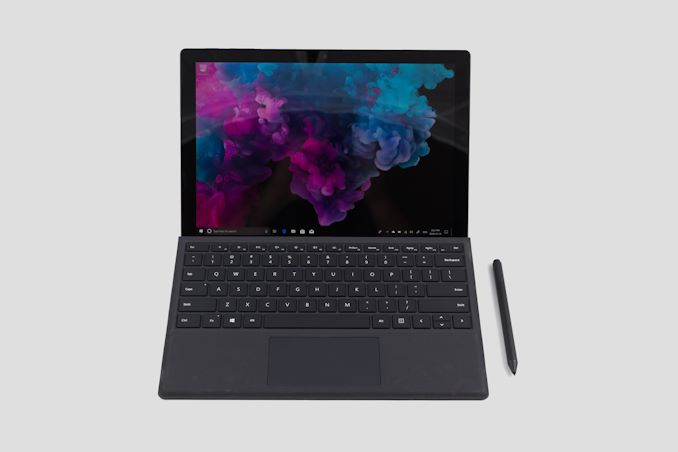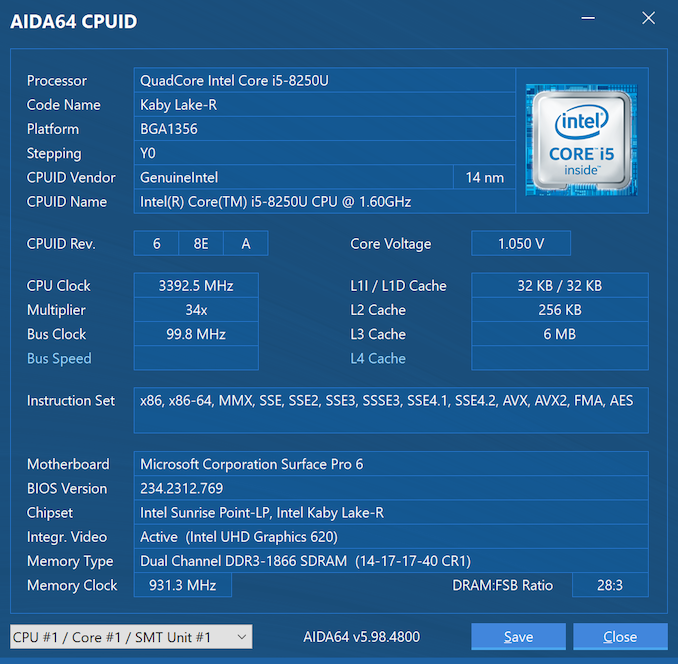The Microsoft Surface Pro 6 Review: More Than A Color
by Brett Howse on October 16, 2018 3:01 AM EST- Posted in
- Laptops
- Microsoft
- Surface
- Tablets
- Surface Pro
- Surface Pro 6

Microsoft is in a bit of a unique place in the PC space compared to other manufacturers. Other than Apple, Microsoft is the only company that controls both the hardware and software sides, and when the Surface lineup launched way back in 2012, Microsoft’s goal was to showcase the advantages of their platform with a premium hardware lineup. On October 2nd 2018, the company unveiled their sixth iteration of what is now a staple in the PC space, the Surface Pro 6.
On the outside, it would be easy to write this refresh off as a spec bump, but there are tangible improvements throughout the Surface Pro which make this a worthwhile successor to the 2017 Surface Pro. The company hasn’t completely reinvented Surface Pro since the Surface Pro 3 launched in 2014, with the move to the new thin and light form factor, showcasing the 3:2 aspect ratio display. Surface Pro 4 stretched the display from 12-inches to 12.3-inches in the same size device, and moved from Haswell to Skylake, and Surface Pro 2017 made some more small tweaks, and with the move to Kaby Lake finally solved the power management issues that plagued the Skylake generation of Surface devices.
Arguably the biggest change that people will see with the Surface Pro 6 is that it’s available in a new color: black. Surface hasn’t been offered in black since the days of the Surface Pro 2, and the new color will live alongside the existing platinum color we’ve come to know throughout Microsoft’s PC lineup. But, inside the device are new components which help move the Surface Pro to a new level. The most noticeable is that Microsoft has moved to the quad-core Kaby Lake Refresh chips, and as we’ve seen throughout the rest of the PC industry, Kaby Lake Refresh brings a significant performance boost.
| Microsoft Surface Pro 6 | |||||
| Model Tested: Core i5-8250U 8GB 256GB $1199 | |||||
| Processor | Intel Core i5-8250U 4C/8T, 1.6-3.4GHz, 6MB L3, 14nm, 15w Intel Core i7-8650U 4C/8T, 1.9-4.2GHz, 8MB L3, 14nm, 15w |
||||
| Memory | 8 GB or 16 GB Dual-Channel LPDDR3 | ||||
| Graphics | Intel Core i5-8250U Intel UHD Graphics 620 (24 EUs, 300-1100 MHz) Intel Core i7-8650U Intel UHD Graphics 620 (24 EUs, 300-1150 MHz) |
||||
| Display | 12.3" 2736x1824 3:2 PixelSense LG Display, Touch and Pen support 100% sRGB color + enhanced color, individually calibrated panels |
||||
| Storage | 128 GB, 256 GB, 512 GB, 1 TB PCIe 3.0 x2 | ||||
| Networking | 802.11ac, 2x2:2, 866Mpbs Max, 2.4 and 5GHz Bluetooth 4.1 Marvell AVASTAR |
||||
| Audio | 1.6 W Stereo Speakers (front facing) Dolby Audio Premium |
||||
| Battery | 45 Wh, 44 W AC Adapter with USB charging port | ||||
| Right Side | USB 3.0 Type-A Mini DisplayPort 1.2 MicroSDXC Card Reader Surface Connect Port (charging and docking) |
||||
| Left Side | Headset Jack | ||||
| Power Button Volume Rocker |
|||||
| Keyboard Connector | |||||
| Dimensions | 292 x 201 x 8.5 mm (11.5 x 7.9 x 0.33 inches) | ||||
| Weight | Core i5: 770 grams (1.70 lbs) Core i5/i7: 784 grams (1.73 lbs) |
||||
| Cameras | Rear: 8.0 MP auto-focus Front: 5.0 MP auto-focus and Windows Hello support Dual microphones |
||||
| Extras | Surface Pen and Dial (sold separately) Surface Dock - 2 x mDP 1.2, 4 x USB 3.0, 1 x Gigabit (sold separately) TPM 2.0 |
||||
| Pricing | 128 GB Core i5 8GB RAM: $899 256 GB Intel Core i5 with 8GB of RAM: $1199 256 GB Intel Core i7 with 8GB of RAM: $1499 512 GB Intel Core i7 with 16GB of RAM: $1899 1 TB Intel Core i7 with 16GB of RAM: $2299 |
||||
One decision that we’ve seen questioned since the launch event was disappointment in the lack of an Iris GPU option in the Surface Pro with this generation. The 2017 model we reviewed was outfitted with the Intel Iris Plus Graphics 640, which doubles the execution units compared to the standard UHD Graphics 620, as well as adds 64 MB of eDRAM. The Iris option is no more though, but even if Microsoft had wanted to continue offering it, Intel no longer sells any 15-Watt CPUs in their current lineup with the Iris option. You’d have to move up to a 28-Watt model at the moment to be offered access.
The rest of the Surface Pro, on a technical specification sheet, is pretty much identical to the outgoing model. The 12.3-inch display is the same 2736 x 1824 resolution, you can get SSD capacities up to 1 TB, and RAM is offered with up to 16 GB as the maximum due to the limitations of LPDDR3 capacities. Also along for the ride is the same Marvell AVASTAR wireless that has been used exclusively in all Surface devices for too long.
The one missing feature that everyone would have likely expected to see with this launch was a USB-C port, since Microsoft finally includes it in place of the mini DisplayPort in the Surface Book 2, as well as on the Surface Go, but in a confusing move, the Surface team has kept the mini DisplayPort connector on Surface Pro rather than move to USB-C which could also double as DisplayPort when needed.
Microsoft has also cut the prices quite significantly, but the very bottom end model with the Core m3 and lowest price is no more. The good news is that the base configuration drops the 4 GB of RAM though, meaning a 128 GB Core i5 with 8 GB of RAM is now the base at $899. Last year the MSRP of the 128 GB Core i5 was $999 and it only came with 4 GB of RAM. At the very top, the savings are even larger, with the 1 TB Core i7 with 16 GB of RAM a full $400 less than the launch price of last year's Surface Pro.











80 Comments
View All Comments
Speedfriend - Tuesday, October 16, 2018 - link
For all the talk of a lack of innovation from Intel, the charts comparing the various generations are quite incredible. 60% improvement in single threaded, 175% in multi, combined with a 100% improvement in battery life.Microsoft has got a winning device here, I see more Surface Pros at conferences than any other type of laptop including Macs, though still behind iPads
fallaha56 - Tuesday, October 16, 2018 - link
you’re bigging up numbers from years and years ago....vanilla_gorilla - Tuesday, October 16, 2018 - link
I'm guessing these are Microsoft conferences? Not sure where you're seeing more Surface devices than Macs or Thinkpads or HP laptops. Surface sells in incredibly small numbers compared to those other manufacturers. And what conferences have more iPads than anything? I'm not sure if you're lying or if you're attending conferences selling timeshares to senior citizens?althaz - Wednesday, October 17, 2018 - link
You're just wrong here. Apple definitely sells more than Microsoft (Lenovo is around the level of Apple with HP and Dell far outstrip the rest). But the different isn't huge. There's no world in which "Surface sell in incredibly small numbers" compared to any other manufacturer's line.When you are talking about premium laptop-ish devices, the Surface line is comparable to the other popular makes. It's smaller than the top 4 - but in its category not by all that much.
melgross - Wednesday, October 17, 2018 - link
I don’t know what conferences you go to, other than those for IT, but I’ve never seen one of these anywhere.With all of the talk about these, as though they’re really important, Microsoft still has to show that they can grow yearly sales beyond the 3 million (maybe!) they barely managed so far. With SurfaceBook sales lower than 500,00 a year, and the Surface PC supposedly in the tens of thousands a year, none of these lines are doing anything near well.
TheinsanegamerN - Wednesday, October 17, 2018 - link
Except that speed increase comes from lower power usage. At the same clocks, intels chips are still not any faster then 3 years ago.Yeah, great, you went from "slow" to "decent speed.". The iGPU is still no faster, max performance is still dependent on the cooling system, and anything that isnt restricted to CFL light-bulb power levels is no faster.
name99 - Wednesday, October 17, 2018 - link
Looking at this sort of improvement misses the reason for concern with Intel.The original CPU (i3-4020Y) is 1.5 GHz, no turbo.
The end point CPU (i7-7660U) is 2.5GHz base, turbo to 4GHz.
Now from one point of view, it's nice that Intel has managed to boost frequency this way while not moving too far outside the power envelope. That helps low power devices (like Surface!) AND it helps large core count server chips.
BUT look at the larger story. It's about lower power, NOT about higher achievable frequencies. The tech that got this does not help that much in boosting the frequency of your 120W desktop CPU in single-threaded mode. Meanwhile, there's been very little improvement in IPC, which can improve performance at the high end.
If you care about some classes of devices, yes, great progress by Intel. But if you care about single-threaded performance at the high end, what's shown here is irrelevant, and just highlights that Intel either through inability or lack of interest is not delivering anything close to the same improvements at the high end.
GreenReaper - Friday, October 19, 2018 - link
The original was a i5-3317U dual-core hyperthreaded 1.7Ghz -> 2.6Ghz turbo. I have one. It's still quite nice, although with the cooling it has it can only maintain ~1.9Ghz under full load with BOINC.Surface Pro 2 and 3 were significant steps back in terms of single-threaded performance, to achieve the "thin and light" goal and improve battery life. That was probably the right decision for the target audience, but given I use my Pro 1 as a second screen I'm glad I got it cheap when the Pro 2 came out.
Eliadbu - Friday, October 19, 2018 - link
The days of CPU improvement are near the endIPC improvement is near the limit adding more instruction to the already large CISC is doubtfully helpful. We are just about the end on how far we can push the clock speed and and adding more cores and threads is useful but to a certain degree. And this is also true for AMD. A new direction should be taken like instead of stack of general purpose CPUs for a all consumers a family of specialized CPUs would good idea.
wr3zzz - Tuesday, October 16, 2018 - link
What is the downside of using a U-class CPU without active cooling? Surface Pro i5 is not the only one. Huawei's Matebook also pairs U-class 15Watt chips without fans.Why won't more companies do this?